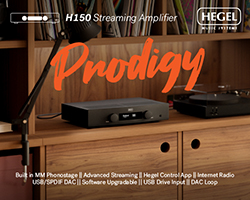WILSON TUNETOT LOUDSPEAKERS REVIEW
Wilson Audio TuneTots are the American company’s smallest loudspeaker that is designed for use on stands or free standing on furniture and shelves. Stuart Smith feels like a kid at Christmas as he takes a listen.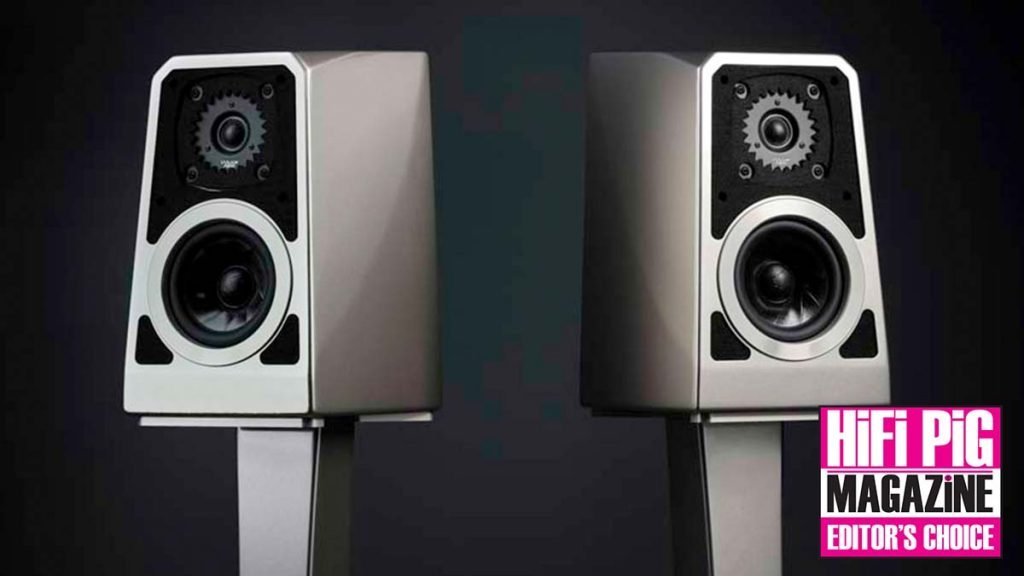
I was really chuffed to have been asked to review the Wilson Audio TuneTots as I’ve never had the opportunity to listen to this iconic American brand’s speakers other than at shows, events, and other folk’s houses. Even better, these are the speakers that belong to Ricardo Franassovici, the larger-than-life owner of Absolute Sounds that are the distributor of Wilson Audio products in the UK. I should explain now that this review comes in two parts and I’m sort of going to get ahead of myself in this particular review; as well as the Tune Tots I was also sent the Wislon LōKē subwoofer and I will be making comment on its use with the TuneTots within this review, but will also be carrying out a full review as a standalone product later on.
WILSON AUDIO HISTORY
I’m sure that if you are reading this Wilson Audio will need no introduction, but I’m going to assume that you, Dear Reader, have been living under a rock for the last 48 years or so.
Wilson Audio Specialities Inc, to give Wilson Audio their full title, was founded by the late David Wilson, previously a writer at The Absolute Sound, and his wife Sheryl Lee Wilson in 1974 and until his death in 2018 David was the Chairman of the company, with Sheryl being Vice Chair. Today it is Daryl C. Wilson who oversees the company as CEO.
Wilson Audio are synonymous with high-end and high-priced loudspeakers and Wiki tells me that the average price for a pair of Wilson speakers is just shy of $69,000, with their range-topping WAMM Master Chronosonic Towers selling from $850,000 depending on the finish you want them in. However, the TuneTots we have here are somewhat more affordable (though you will still need to dig pretty deep) at £12,995 and up.
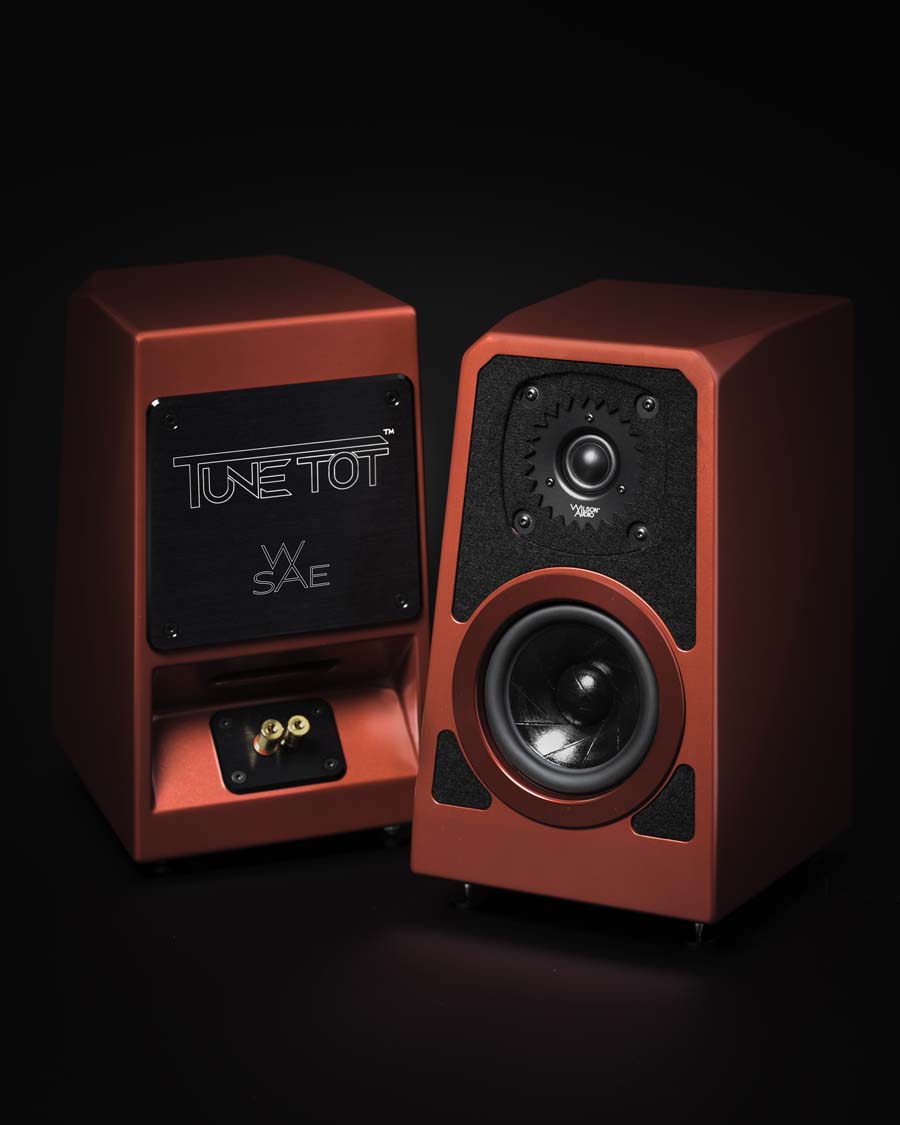
The Wilson TuneTots are a good-sized monitor and available in lots of colour options.
STEP UP TUNETOT
TuneTot is a standmount monitor from the Wilson Special Applications Engineering (WSAE) team and its name pays homage to WSAE’s first product, the Wilson Audio Tiny Tot (WATT). Whilst the TuneTot is the least expensive loudspeaker in the Wilson range, the company tells us that they are made by the same team of craftsmen that build the top-of-the-range WAMM Master Chronosonic and uses the same processes in its construction and with cabinet and driver tech coming straight from the company’s Alexx V and SabrinaX floorstanding loudspeakers.
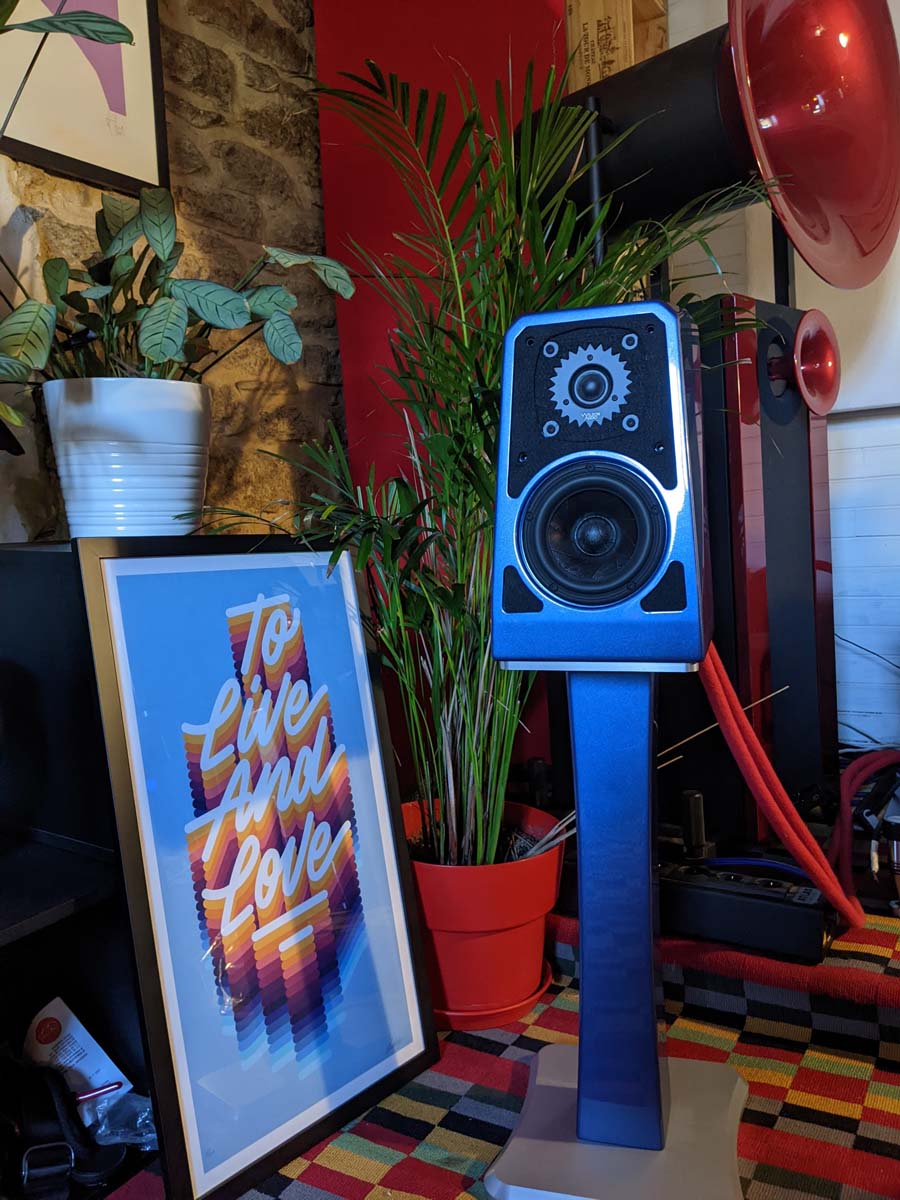
The TuneTots have a dedicated and colour-matching stand that is available as an extra.
FIRST IMPRESSIONS OF TUNETOT
Like it or not, first impressions count and Wilson Audio have got that Christmas morning effect that Lin and I talk about down to a fine art. Everything in the packaging feels like you are experiencing something special; the brochure that comes with the speakers is lovely, glossy and thick, and even the high-density packaging material that has been laser cut with relevant logos feels properly high-end. This stuff is important; imagine buying a fifteen-grand watch and having it arrive in crappy and ill-thought-out packaging – you’d be mightily miffed, for sure! Anyway, Wilson knows how to do Christmas morning and my initial thoughts of “these are too expensive for little monitors” soon evaporated and I was left really impressed by them – even before properly unpacking. There’s even a properly laid out tool kit that comes with the speakers to attach them to the matching stands (an extra £3998) along with spikes and bolts for the speakers and stands. I love all this kind of stuff, it’s sort of prolonging (and adding to) the excitement of unpacking and getting to the main part of your gift to yourself, and so many audio companies either see this as an unnecessary expense or simply don’t get the fact that adding a few percentage points to the overall price of a product really makes the whole buying/receiving experience so much better.
The speaker stands are lovely, by the way; solid, very heavy and with matching colour pillars. Yes, they cost a lot and take the final price to over £15,000, but if I was buying these speakers for myself I’d want them.
And then you get to the speakers themselves; they are reassuring cold to the touch…and bloody heavy for such small speakers. They feel “right”, much in the same way that a (to use a horological reference again) nice watch feels “right”. Yes, I hear you cry that it’s only the sound of a product that matters, and to a degree, I agree with this sentiment, but as human beings we are influenced by so much more than the principal purpose of a product and I refer you to my previous comments on this topic.
Anyway, so far the whole experience of my time with the TuneTots has been a positive one and had I just shelled out the required fee for entry, I’d have been pretty smug with my decision in choosing such a gift for myself.
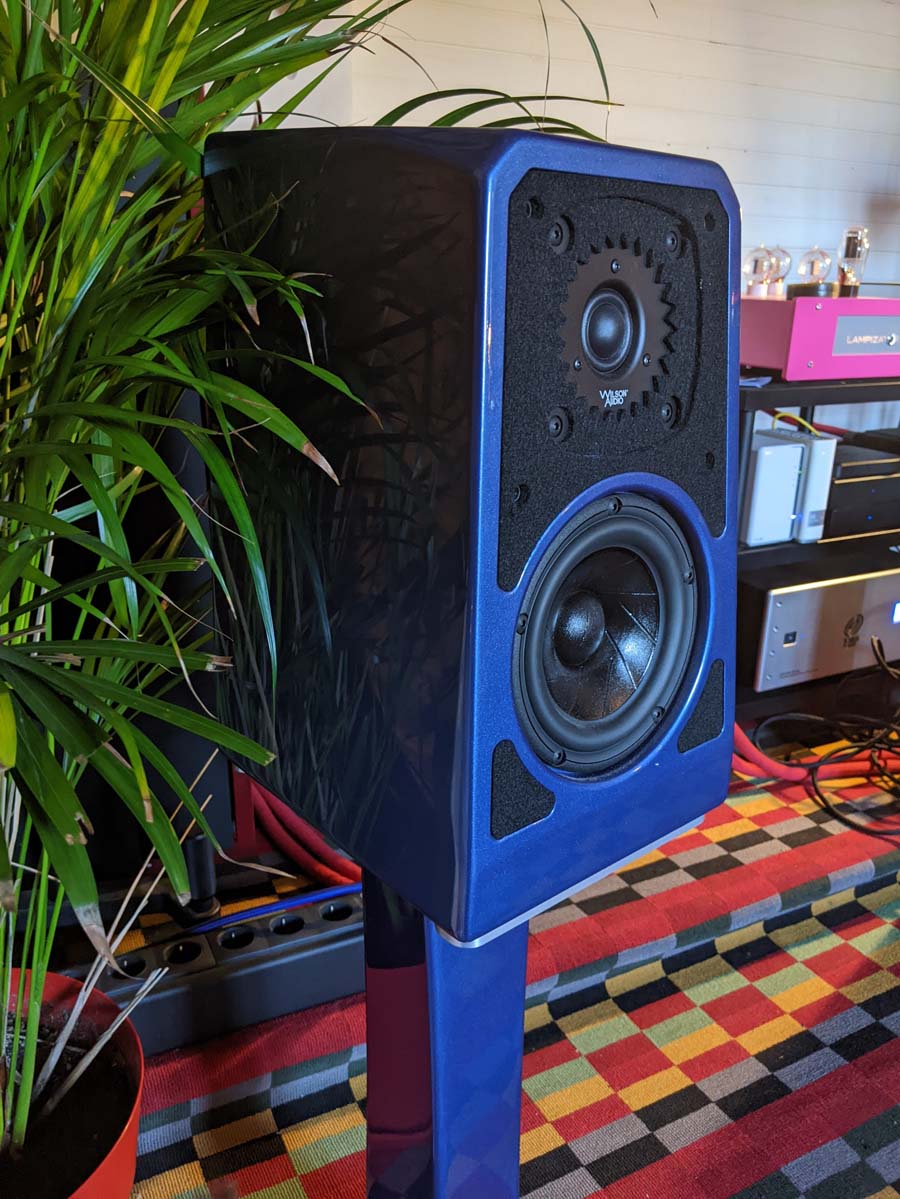
Whichever way you look at the TuneTots they are an attractive proposition.
WILSON TUNETOT BUILD AND FEATURES
I’ll get the speccy stuff out the way first of all. The TuneTots are a two-way, rear-vented speaker with a 5.75” doped paper pulp mid-woofer and a 1” doped silk fabric domed tweeter. They are 86dB sensitive (so I’m expecting them to like an amplifier with a bit of clout) and have a nominal impedance of 8 ohms. Frequency response is +/- 3dB 65Hz to 23kHz and as someone that enjoys a properly full-range listening experience, particularly down low where I share Charlie Haden’s thoughts on the matter (“The bass, no matter what kind of music you’re playing, it just enhances the sound and makes everything sound more beautiful and full. When the bass stops, the bottom kind of drops out of everything”) this sort of worried me. However, this love of bass needs to be tempered somewhat and I am well aware that trying to shoehorn a speaker with too much bass into a room that is too small to deal with that bass can be counterproductive and lead to all kinds of problems. Here I think that Wilson has made a sensible decision; a speaker that goes low enough for most, with the option of adding a sub for those that have larger rooms and that demand a lower response- more on this in a while.
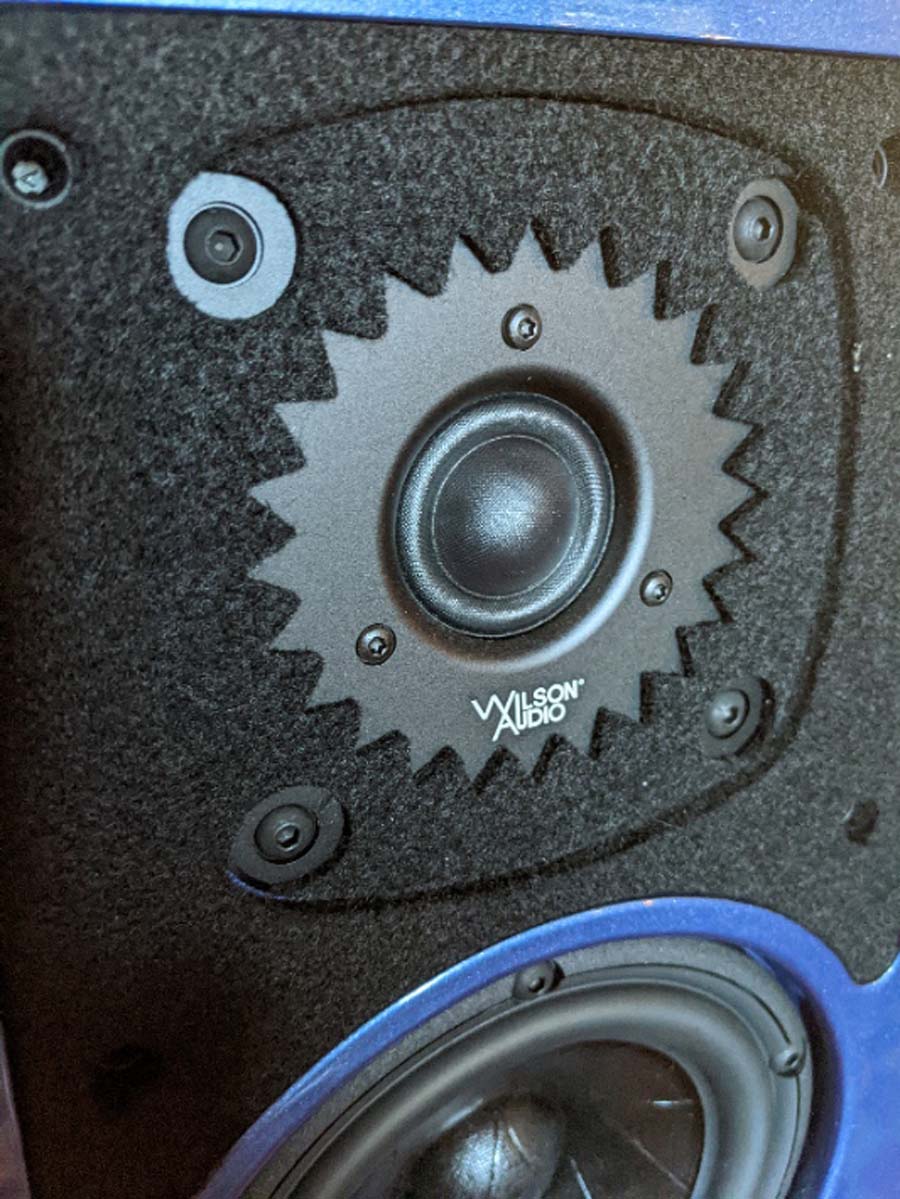
The diffusion material around the domed tweeter aids dispersion and hence imaging.
The speakers are not tiny, but not huge (Goldilocks would approve) and stand almost 15” high, 8.61” wide and 10.19” deep. They weigh 13.15 (29 lbs) per speaker.
The speakers themselves are made up not of MDF or Plywood, but rather a combination of two of Wilson’s patented composite materials – Wilson X- and S-Materials. The idea here is to create a cabinet that is free of vibration and Wilson uses a “laser-vibrometry system” to measure and optimise the cabinet’s thickness and composite makeup. In addition to the solid cabinets (they are dead to the knuckle-rap test) the TuneTot’s cabinets are asymmetrical (no internal surfaces are parallel) to eliminate standing waves that can colour the sound in conventional box-type speakers.
Attaching the speakers to the stands is a case of turning the speakers upside down and bolting the stands to the holes in the speakers. It’s here where you realise that everything about these speakers is built to very tight tolerances and the bolts “just” fit in that kind of “that feels right” kind of way.
Now, the speakers are designed to also fit on shelves or even desk-tops and you get different lengths of spikes (and shoes) to ensure the speakers sit correctly on your chosen surface and are correctly aligned in the time domain. You will need to buy the ISOBase which will add to the cost. Sadly, I just don’t have the kind of surfaces or shelves to accommodate speakers and so the TuneTots will be tested only on their stands.
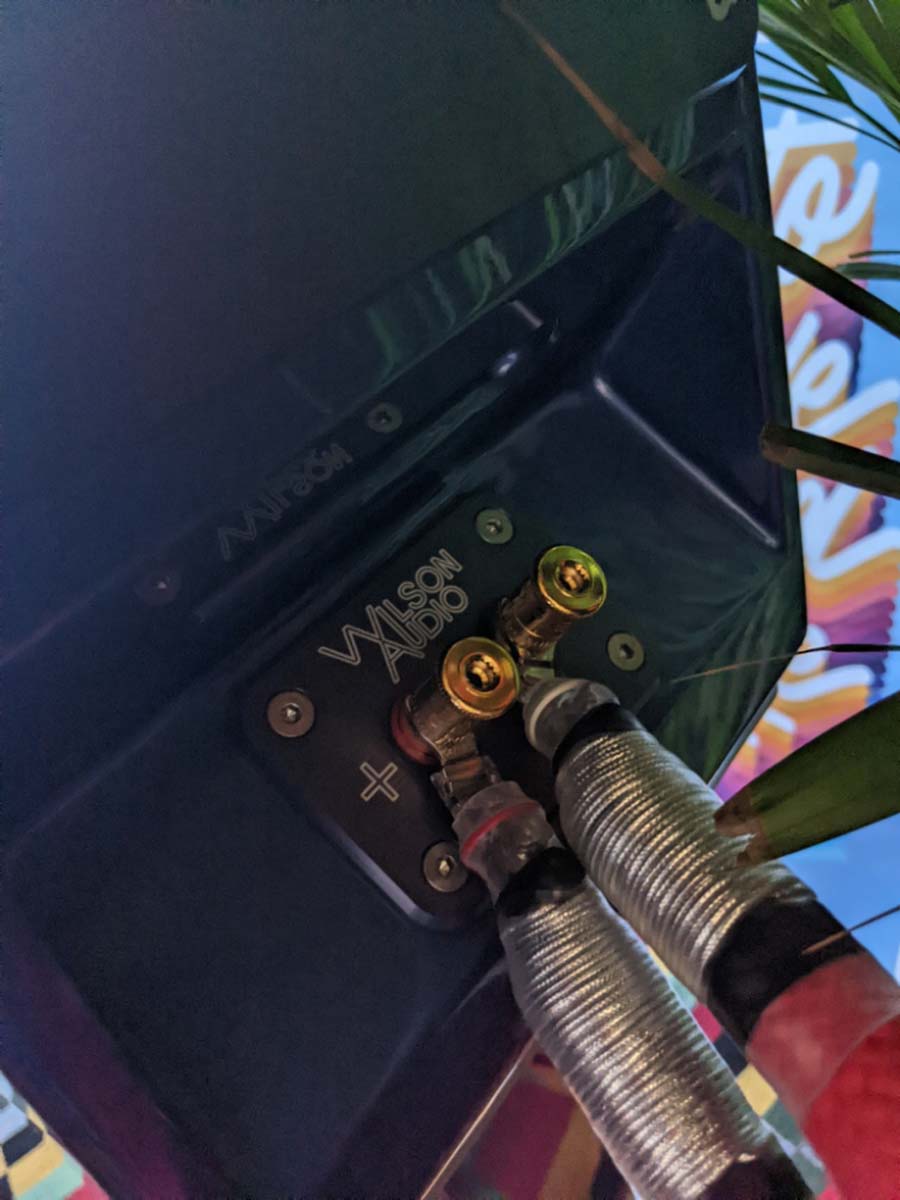
Around the back of the TuneTots showing the quality binding posts.
WHAT DO WILSON TUNETOTS SOUND LIKE?
I hooked the TuneTots up to our totally renovated (by Krell in the US) Krell KST100 amplifier with a Leema Libra preamplifier before it. Actually, I guess that the natural partnering would be one of the newer D’Agostino amps, but the Krell is as near as I can personally get to that. D’Agostino and Wilson sort of seem to go together, much in the same way that gin and tonic sort of go together, and Absolute Sounds that distribute Wilson in the UK also distribute the D’Agostino range of electronics – canny. Other elements in the chain were our Lampizator DAC (Big 7 but brought up to a much higher spec’ by Lukasz at Lampizator), a Stack Audio streamer with associated network peripherals, and with everything electronic, including all things networky, going through a Torus mains transformer unit. Cables were by WAY (speakers), Atlas (power), and Tellurium Q (interconnects). This is a well-known (to me) and well-sorted system!
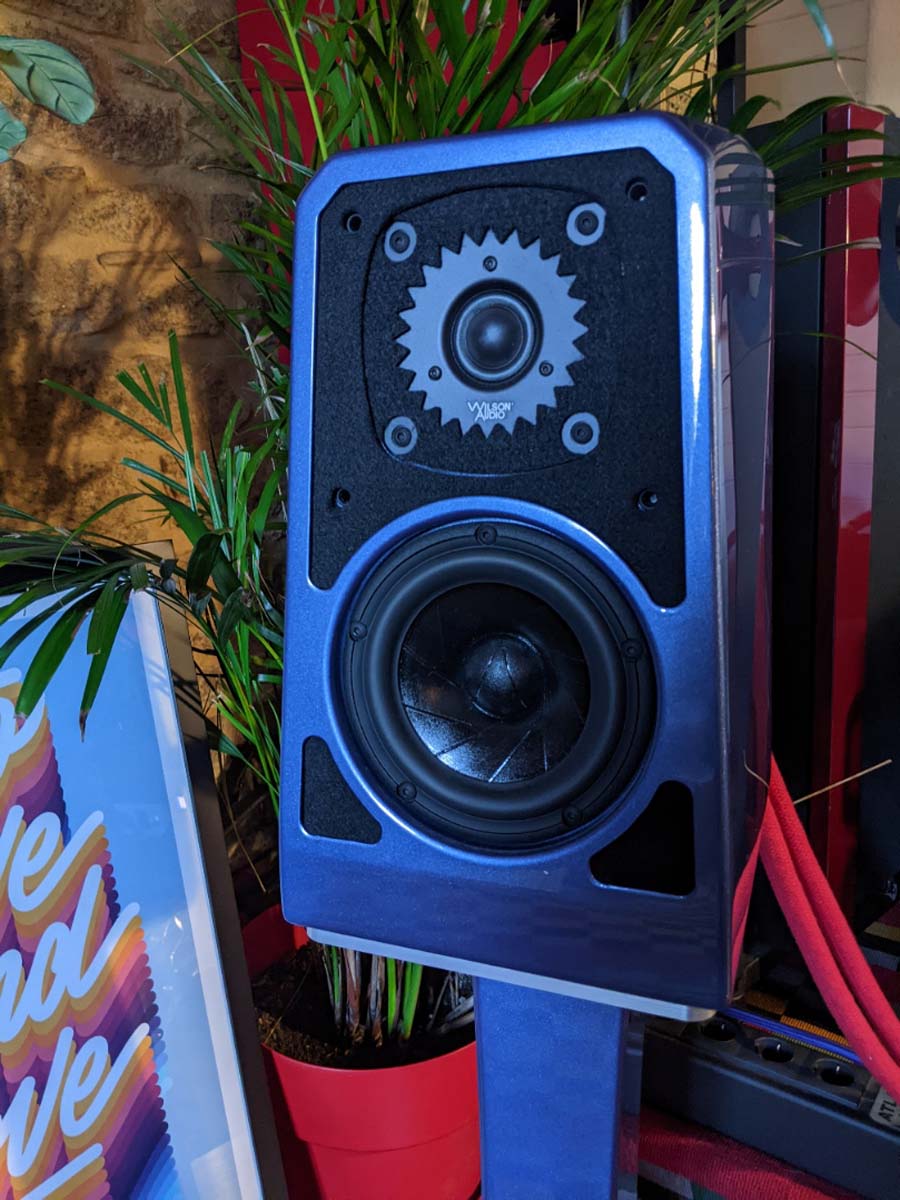
The review samples came straight from the home of Absolute Sounds’ boss Ricardo and arrived in a wonderful shade of blue.
Speakers were set up about three metres apart and well away from room boundaries both to the sides and the back.
So, first of all I listened to the TuneTots without their associated sub; in fact I listened without any sub at all, as I wanted to get a true feel of what these speakers are capable of without adding further complications or expense to the already pricey package.
As I often write in reviews, it’s difficult not to go into a review without having a preconceived idea of what a product is going to sound like and with the TuneTots I expected a refined speaker that majored on mid-band presentation, was a bit polite for my own personal taste, but one that imaged really well. Let’s see.
Fleetwood Mac’s Landslide was up first, for no other reason than it was what I’d been listening to previously and the first thing that grabbed me was indeed the imaging these speakers give, not wholly unlike the Raidho X1T speakers and their larger counterparts with their ribbon tweeter, though, of course, the tweeter on the TuneTots is more conventional. The stereo image is not exaggerated and actually sounds very natural and without a feeling that it is being artificially pushed to create something that is initially impressive but in reality overblown and in the final analysis tiresome. There’s also a speed and what I perceive as being accuracy to the way the guitars are portrayed in the mix. There’s no doubting these are a very detailed loudspeaker – as a monitor should be. The vocal line in this tune is out in front of the speakers and central, though not so lineated as to sound contrived, whilst the slightly muted lead guitar sits properly back in the mix. Roon throws up Yellow Brick Road (not a tune I listen to a lot) but the piano at the start of the track grabs my attention as being natural sounding. The drums sound punchy and very tight. Hard to believe in this decent sized room that these speakers only do down to 65Hz. I actually let Roon play through for a few hours to do its thing and I had no complaints with the likes of Tracy Chapman, Natalie Merchant (Ladybird sounded fantastic!) etc. and how the speakers portray this kind of music. However, this is not particularly testing music, though I must confess that I was really drawn into just listening to the tunes; this is a good thing in my book and rather than wanting to pull the speakers apart and “review” them I just wanted to sit and listen to music…and so I did.

Another look around the back of the TuneTots
They’ll not like Dub as their bass response will be wholly unsatisfactory! So, from 1990, on goes Dub Syndicate’s Strike The Balance and in actual fact I don’t think I’d say the bass was missed all that much at all; the room certainly felt energised enough at the bottom end, though as a self-confirmed basshead that knows this album inside out, I knew it wasn’t there. I refer readers to my previous comments about Wilson actually being pretty canny with regard to the bass response of these speakers and it being a sensible move to allow them to fit into modern living spaces. Moving on from the bass, a big thing about this kind of Dub Reggae music is the whole thing of effects; splashes of reverb, delays, and mental panning between the speakers on the desk. This all comes across really well on the TuneTots and, leaving all their luxury pretensions aside, these are actually a very good sounding speaker that does a lot of things that I really enjoy given the type of music I listen to – not what I was expecting! On dub, the spatial thing is really important (as I said) and these speakers do that very nicely, thank-you-very-much! The reverb on the snare of Stoned Immaculate from the album of the same name is incredible – tight and properly “there”. A bit of a revelation for me if I’m honest and I sort of really want a pair now. Again, I listen to this album and more dub that Roon throws up without really thinking I’m listening to a pair of standmounts that in spec terms I’d say are a bit bass-disabled.
OK, on goes Dusty Kid III which is a workout for any speakers and the opening track “Crepuscolaris” does highlight that these speakers are missing what I’m used to having with our Avantgarde DuoXDs and their double 12” 100W a side active bass units and to an extent our Audiovector R6 and their isobaric bass units. However, you can’t get a speaker of this size to go that low and the truth is that you quickly become accustomed to the sound of the speakers and they are so good in other areas that you soon forgive them too – on the next track, Far, the TuneTots come into their own again and have the delayed and reverbed hat appear in the middle and above the speakers and then retreat to the back left of the soundstage. I’ve probably said this in reviews before, but I really do like a very good standmount speaker for the way they image and the TuneTot is a very good speaker in this regard. Whilst listening through to the Dusty Kid record I kind of forget I’m listening to such a modestly proportioned loudspeaker and again just get lost in the tunes.
Sketches Of Spain seems appropriate and it’s here where the TuneTots (unaided) really shine. Tonally these speakers appear to be spot on and really uncoloured in how they get the music across to the listener. Instruments are heard individually in the soundstage before the listener and yet without an artificial lineation (again). It’s a glorious thing to behold at medium volume, with the almost-hidden details of things like the hats in Concierto De Aranjuez coming through the recording beautifully. These are small details, but details that set the very good apart from the merely good.
So far the TuneTots have been a real delight to listen to. Their main attributes are speed, uncoloured tonal accuracy, and a sense that the musical soundscape is laid out properly and without artifice or exaggeration. I had expected to have whined on about how they were in no way a proper speaker for serious listening given their very modest lowest bass output, but the truth is that I genuinely didn’t really notice that too much at all, but always in the back of my head I had that quote I mentioned of Charlie Haden and wanted to try the TuneTots with the Wilson LōKē sub I’d been sent for review. I’ve got a proper review of the LōKē underway and it will tell you that this is the smallest sub that Wilson make, has been built specifically to partner with the TuneTots (though it will work with any other relevant speakers) and that it costs about £9500 – taking the current speakers system (including stands) to about twenty-five grand. This is, of course, a lot of money, but everything I’ve batted on about so far with regards to the price of luxury items stands.
The addition of the LōKē, which can be hidden away if you must, makes for a relatively compact (the sub really isn’t that small at all when compared to the likes of the REL t/5i that we have a couple of) and unobtrusive solution that looks fabulous.
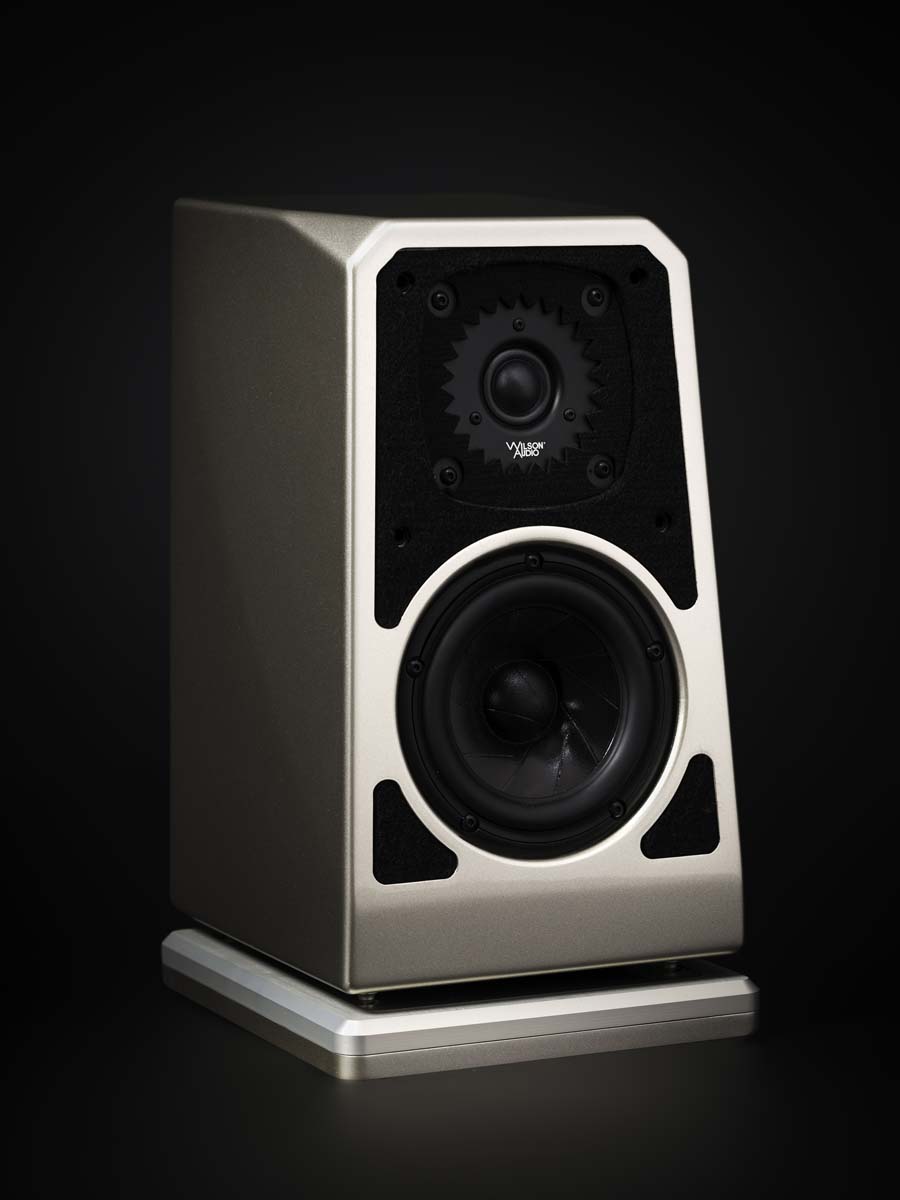
To allow for different and varied placement there are a few options of ancillary kit to choose from.
So here goes…
For me a sub shouldn’t really be heard, rather it should just do its thing and flesh out in an unobtrusive way what is already there. The LōKē sub is very easy to set up and with a lot of fine adjustment possibilities for the parameters available; this means that you can get it working just as a sub should relatively quickly; I spent around twenty minutes dialling it in properly.
For me, the sub does add a good deal in this room, though it is a larger room, but I am guessing that in a smaller room the LōKē has enough (and fine enough) parameter options for you to tone it back so that it never gets in the way in an intrusive manner. I also guess that the rigidness of the cabinet on the sub and the internal bracing ensure that all you are hearing is the driver and not the cabinet vibrating away.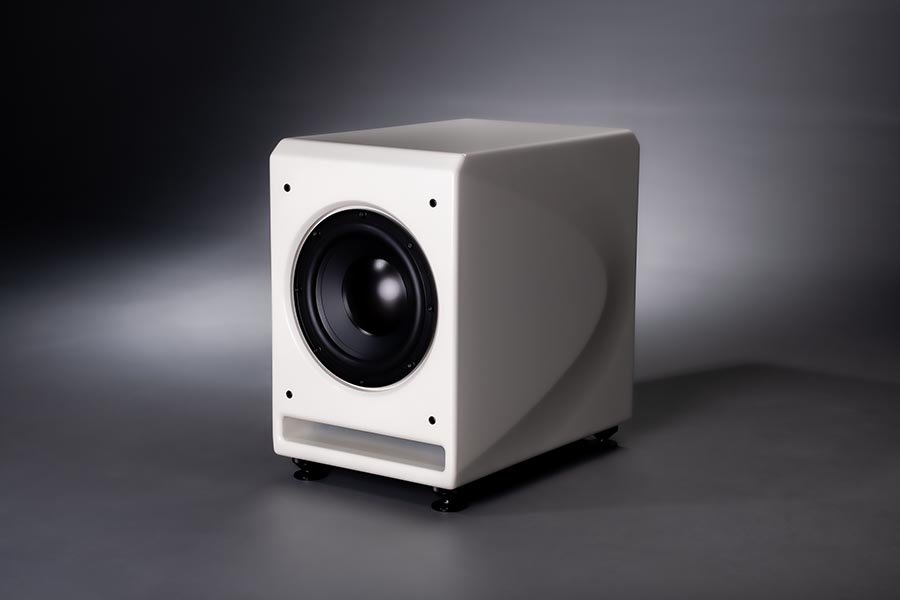
I played a lot of the same tunes I mentioned above when the sub was in place. Dub Syndicate’s Strike The Balance was fleshed out and there was more of a feeling of the power of dub, which, of course, comes from the relentlessly pounding bass. However, what was also apparent was that the TuneTots lost none of their own abilities with regards to the way they reproduce everything above 65Hz and they still had that wonderful ability with regard to imaging and soundstaging. Fleetwood Mac’s Dreams had that wonderful walking bassline more to the fore (obviously) but having the sub also seems to add to the overall “feel” of the other frequencies, despite not adding anything above, if I remember correctly from my setting it up, 125Hz.
Whatever, it works well with the TuneTots, and whilst I wouldn’t say it is an essential item to have with these speakers given my experiences with the likes of Dub Syndicate, I did prefer the set up with the sub in place! It’s all going to depend on your room as to what you end up buying.
CONCLUSION
If you don’t get the concept of high-end and it’s not something you buy into, for whatever reason, then don’t buy these speakers, they are not for you. However, if you want to feel pride in ownership, like to feel as though you have what some perceive as being the best, as well as great performance then you will “get” the TuneTots.
I’m going to use the watch analogy again. You can go out and spend a lot of money on a Rolex (other high-end brands are available and many more expensive) watch and it will be beautiful, keep good time and you will “feel” something whenever you put it on your wrist and wear it out. You can go out and buy a Tudor (owned by the same company) and this will cost you a lot less but still keep good time, and if this is what you can afford then you will be more than happy with your purchase. However, it won’t be a Rolex and it won’t have quite the same quality of fit and finish. You will also know the Tudor is perceived as the lesser of the two watches. You can also go out and buy a quartz watch for a few quid and it will keep perfect time, most likely much better than the other watches I mention, but it’s not going to be a Tudor and it’s certainly not going to be a Rolex. If you don’t “get”, or should I say “buy into “ this analogy, then perhaps these speakers are not for you. Here’s another analogy. When I bought my first Leica camera I scoured the internet for the best lenses for it and was certain I’d found a 35mm lens by Voigtlander that performed as well or even better than the Leica equivalent but for a fraction of the cost. Someone told me it was a waste of money as in the back of my head I’d always know it wasn’t a genuine Leica lens. They were right and I ended up barely using the Voigtlander, though it was an excellent lens, and buying a Leica 35mm lens with which I’m over the moon and use pretty much daily. Again, some will get this analogy and others will think I’m off my rocker – for the record, I’m fine with the state of my rocker.
All the above is a round-about way of saying that there are always going to be some people who don’t, for whatever reason, buy into the idea of luxury products and then there are those that can and do buy into it – it is for the latter that the TuneTots are created.
I actually set about reviewing these speakers with the thought that they wouldn’t be my cup of tea at all other than being good standmounts which I enjoy for their imaging. I also thought I’d end up moaning about their performance-to-price ratio, despite all I batted on about with regard to high-end audio. After a lot of listening to them, all I can say is that they really won my heart and ears over with how they present music. They are free from artifice and tonally uncoloured. They are detailed and yet free of harshness at the top end. Yes, without the aid of a sub they are challenged in the bass department, but then the question is, are they really challenged or are they actually a very sensible compromise for the modern home?. And, yes, they image wonderfully, creating a soundstage that extends well out into the room and then beyond the speakers behind and to the sides. The diffraction padding around the tweeter I feel helps a great deal with the way these speakers image.
The Wilson TuneTots are a nice speaker; in fact, they are a very nice speaker that are finished really beautifully, come with all the high-end things that make them feel special, and they sound pretty damned good to boot.
Were I in the market for a standmount speaker that is also designed to be perfectly happy on a (big) desk or on a sideboard, and I had the available funds, then the Wilson Tunetots would be on my shortlist. What else would be on that shortlist that ticks all the luxury, engineering, and sound requirements, I don’t know. I’d also want the matching sub as we have a large room and this takes us to £25K, at which you have some very good loudspeaker options.
Expensive, yes, but you will either “get” that expense or not. Those that do “get” it and end up buying a pair of these speakers will be well pleased with themselves!
I loved every minute with them!
AT A GLANCE
Build Quality:
From the packaging to the speaker itself I cannot find fault. From receiving the parcel to unpacking the speakers and stands this great experience
Sound Quality:
Imaging is fantastic
Uncoloured and natural sounding
Classy through the midband
Surprisingly unfussy about the music they have played through them
Limited in bass output
Value For Money:
This is a tough one to answer and one that is going to depend on the particular person’s subjective opinion on what represents “good value”. If you buy into the high-end concept then they are good value. Conversely, if you don’t buy into that then they don’t. Yes, they are expensive but, particularly with the sub, they sonically rival speakers we have to hand that cost similar. The price of these speakers will, I’m sure, be a cause for much debate.
We Loved:
The feeling that you have bought into a luxury product
Fit and finish of everything from the packaging and ancillaries to the speakers themselves
Their uncoloured and tonally accurate portrayal of music
Imaging is fantastic but not overblown or artificial
We Didn’t Love So Much:
Bass extension is limited
Price to absolute performance in sonic terms
Elevator Pitch Review: The Wislon Audio TuneTots are the smallest of this American icon’s loudspeaker offerings, but they bring with them much of the technology used in their bigger and more expensive siblings. They are designed to be a practical monitor with a number of options with regards to siting, though I guess that the best performance is achieved on their dedicated stands. They are a luxury product in every sense, but that is not an insincere luxury where if we scratch the surface we are left wanting – the TuneTots sound excellent too. They are an open, uncoloured, and natural sounding loudspeaker that image superbly, though some will feel they are lacking in ultimate bass performance.
Price: Around £12,998 – 13,998 for the speakers and stands around £3000 depending on the finish

Stuart Smith
SPECIFICATIONS:
Woofer: 5.75 inches (14.61 cm) Rear vented doped paper-pulp
Tweeter: 1 inch (2.54 cm) Sealed, Doped Silk Fabric
Sensitivity: 86 dB @ 1W @ 1m @ 1k
Nominal Impedance: 8 ohms / minimum 6.61 ohms @ 172 Hz
Minimum Amplifier Power: 25 Watts per channel
Frequency Response: 65 Hz —23 kHz +/- 3 dB Room Average Response
Height: 14.83 inches (37.67 cm) w/o spikes
Width: 8.61 inches (21.87 cm)
Depth: 10.19 inches (25.88 cm)
System Weight Per Channel: 13.15 kg
Total System Shipping Weight (approx.): 31.75 kg


























































































